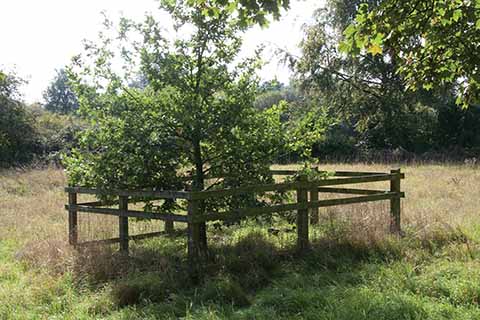An unfit monument
Roger Guttridge praises efforts to revive the memory of a Dorset printer and publisher
Published in January ’20
In a field near Sherborne lie the remains of a man whose contribution to Dorset and wider history has been widely underestimated. The second edition of Hutchins’s History of Dorset says of printer, publisher, author and bookseller Robert Goadby: ‘Few men have been more generally known in the West of England than he was, and few have had more friends, or more enemies. Truth was the object of his researches, in the pursuit of which he was indefatigable. His knowledge was of course considerable, and he was well versed in several languages. The productions of his press were numerous; almost all of them of a moral or religious tendency.’
For reasons unknown, Goadby and his wife, Rachel, are buried in unconsecrated ground barely ten yards outside the churchyard of the chancel at Oborne. The ancient chancel – the only surviving part of St Cuthbert’s Church – can be seen to the left of the A30 as you drive between Milborne Port and Sherborne. Goadby acquired the burial plot some time before his death in 1778, aged 57, and is said to have walked there daily from his home in Long Street, Sherborne, enjoying nature and admiring a view from Oborne that is now obscured by the railway embankment.
Until 1977, the grave not only was protected by a square of iron fencing but included an inscribed headstone praising nature as our link to God and describing a fir tree that originally grew out of the grave – a tree ‘clothed with everlasting verdure / Emblem of the good, and of that everlasting life…’ It is ironic that this tribute in stone to two enthusiasts for the natural world eventually fell indirect victim to Dutch elm disease. By the mid-20th century, the fir had long since given way to an elm, its progress assisted to maturity by the very same fencing that also guarded the headstone. When the diseased tree was felled in 1977, the fellers also removed the railings and shattered the stone. ‘With the cutting down of this tree, his [Goadby’s] entire monument has been destroyed,’ bemoaned an article the following year in Dorset: the County Magazine, forebear of Dorset Life. ‘Its site is completely obliterated.’
The railings have since been replaced by a wooden fence and the elm by a youthful oak. But of the memorial stone only fragments remain. Happily a group of heritage enthusiasts are hoping to put things right – although even this simple aim has not proved challenge-free. ‘Originally we hoped to have a new gravestone erected to replace the one that was destroyed,’ Barbara Elsmore tells me. ‘We obtained a grant from the Simon Digby Trust, only to find that because it is on private land with no public access, we can’t put a headstone there and no-one can visit it. We are therefore proposing an information board on Goadby to be hung in the chancel. We recently put some proposals to the Queen Thorne PCC and the Churches Conservation Trust and hope to receive a response soon.’
Goadby spent almost all his adult life in Dorset. His and Rachel’s only child, Robert, died in 1756 aged six or seven and is buried in Sherborne Abbey. Goadby is best remembered as the owner of Dorset’s first newspaper, the Sherborne Mercury. He bought the title from Hannah Bettinson, widow of founder William, and merged it with his own Yeovil-based paper to become the Western Flying Post or Sherborne and Yeovil Mercury. He moved the whole operation to Sherborne in 1749.
Despite its new title, the paper continued to be known among readers as the Sherborne Mercury. It became the recognised medium for property advertisements and was vigorously promoted by Goadby, who sent free copies to the coffee houses of London, Bath and Bristol. The paper reflected its owner’s ‘unwearied exertions’ for the poor, strong moral compass, gentle take on politics and zeal for the freedom of the Press. An inscription above his Long Street printworks proclaimed: ‘The liberty of the Press and the liberty of the people fall together. Long may heaven avert it.’
Goadby’s distribution agents were known as ‘Sherborne Men’ and supplemented the printed news with up-to-date gossip gathered on their journeys. One son of a Sherborne Man described the Mercury as ‘the only newspaper known to the common people’. Another admirer wrote: ‘Great was the anticipation of the Sherborne Rider with spattered boots and bestriding his bulging saddlebags, from which latter he dispensed to the eager crowd his Mercury and Entertainer, took the money and orders of new customers and he was off.’
The education of the public was Goadby’s strongest motivation and he produced numerous other publications including the long-running Book of Fairs, and, in three volumes, The Family Library. The Mercury was eventually taken over by the fledgling Western Gazette in 1867. When he died a decade later, Goadby left £200 to Sherborne’s poor and £2 a year to the town’s vicars on condition that they preached an annual sermon ‘on the wisdom and goodness of God in creation’. It was still being preached 100 years later.


